Well-Being & Ecology _|_ Issue 8, 2018
YOGA: A SPIRITUAL PRACTICE FOR OUR TIME
An interview with Judith Hanson Lasater
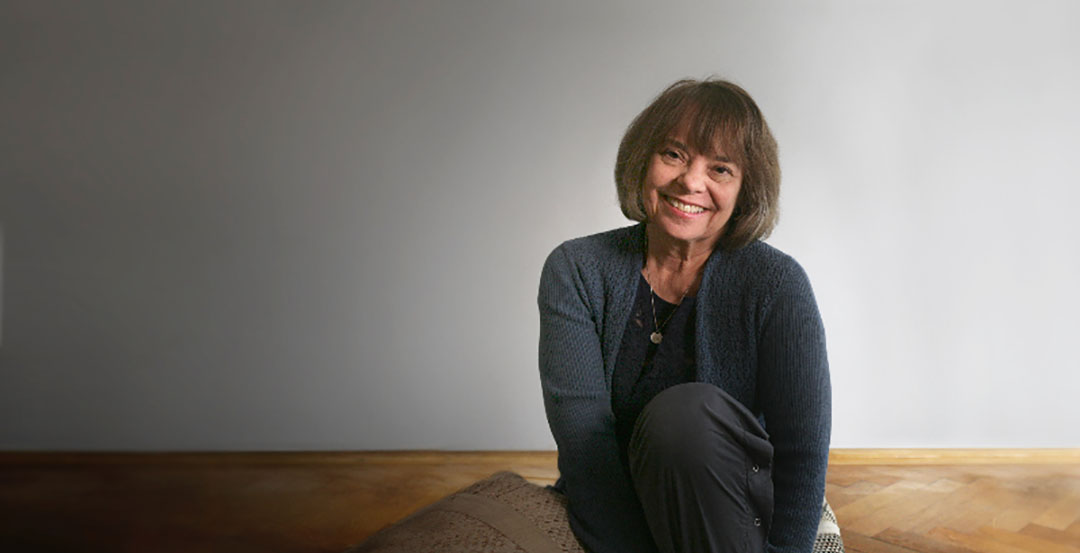
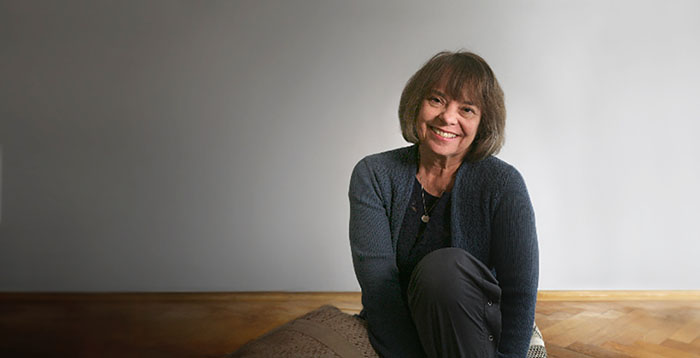
YOGA: A SPIRITUAL PRACTICE FOR OUR TIME
An interview with Judith Hanson Lasater
Judith Hanson Lasater has been a leading force in the development of yoga in the US for over four decades. She trained in the Iyengar tradition, studying personally with B.K.S. Iyengar for many years. She is one of the founders of the Yoga Journal, and president of the California Yoga Teachers Association. She is also a physical therapist and holds a PhD in East West Psychology. She has written nine books; her latest, ‘Restore and Rebalance: Yoga for Deep Relaxation’ (2017), develops a programme of yoga which specifically aims to counteract the effect of stress in our modern lives. Interview by Elizabeth Roberts.
 Elizabeth: You started practicing yoga in 1970 when it was comparatively little known or understood in the western world. Why do you think it has become so extraordinarily popular over the past 40 years? What is its appeal?
Elizabeth: You started practicing yoga in 1970 when it was comparatively little known or understood in the western world. Why do you think it has become so extraordinarily popular over the past 40 years? What is its appeal?
Judith: I think the main factor has been sociological forces – the speed with which technology has invaded and dominated our lives; the falling away and questioning of traditional religions; urbanisation, which means that most of us are no longer living in a community but next door to people we don’t even know; the speed at which life is moving. All of these things have affected us. Throughout most of our evolution as human beings, we have lived in fairly small settled communities: villages of about 150 people seem to be about the ideal size, providing just enough diversity. But now we don’t generally live around people we have a relationship with. So I think that yoga is something that people see as a way to have community, and a spiritual connection that is not religious.
Elizabeth: It is interesting that you mention the desire for a spiritual connection. It seems to me that although many, if not most, people come to yoga initially as a physical exercise to improve their health, or to get fit, or deal with stress, it is a very good practice for people who want to go deeper into their nature but don’t want to take on a religious form.
Judith: Actually, even if people come to classes just to improve their health, yoga is never about going out – meaning, achieving an external result. It’s always about going in. The west has taken up the practice of the physical postures – āsana – but if we look at the original writings of the tradition, such as Patanjali’s Yoga Sutras [/] we find that āsana is just the third component of an eightfold path. The first two steps, yama and niyama, are ethical precepts: yama is about abiding by principles such as truthfulness and non-violence, whilst niyama is about cultivating virtues such as purity of mind and acceptance. The next one, the fourth step, is prānāyāma, control of the breath. But even with āsana and prānāyāma, the intention of yoga is to pay attention to the body, not just to exercise it. We listen to the body; we feel the body; we become aware of its distinctions and its sensations. Similarly, breathing is a very intimate activity. The breath comes inside us; we give something to it and then it leaves us. It’s a dance.
I think that human beings have a natural inclination towards questions such as: “What’s it all about? What am I doing here? Where are we? How did we get here? Where are we going? How do I fit into this? Who am I?”. If you have a teacher who is teaching āsana but doing it in the widest context – within the broader spectrum of the psychological, the emotional, as well as the physical, energetic – then yoga can be a roadmap to understanding the self. It’s a roadmap that can help us to discover our innate sense of equanimity. It shows us that while the body is a great tool, it’s not the answer; while the breath is a great tool, it’s not the answer; while the mind is a great tool, it’s not the answer – simply because we will never figure out the really important things with just thought alone.
So yoga is much more than a philosophy, which can just be an intellectual activity. It’s a matter of sitting on a cushion and watching our thoughts, and then carrying that introspection over into an awareness of our hamstrings stretching in dog pose. Or it can be sitting on our cushion and watching our minds move around like a jumping bean. If we are alive and noticing what is happening, over time we will find what I like to call the ‘pause’. If we practice this introspective attitude of noticing the arising of emotions and sensations, we eventually find that we have a moment’s ‘pause’ before we go into full-blown reaction to whatever is happening to us.
That is the freedom that yoga offers: it allows us to find that moment when we can choose the empathetic response, the compassionate response. We are training our neurology to concentrate first of all on what is arising within us, instead of quickly judging – or acting or reacting to – outside events. And this is one of the best gifts that we can be given as human beings: that pause which allows us to choose our actions. This is because all our actions, all our thoughts, shape the world: not just our own private world but the whole world around us.
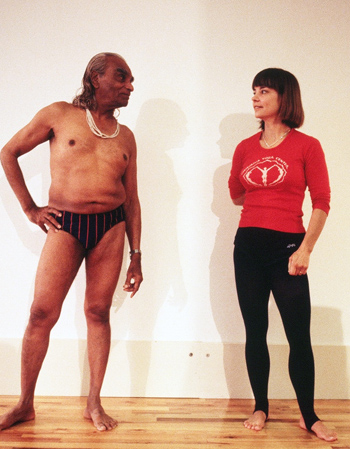
Judith with B. K. S. Iyengar
Elizabeth: This reminds me of Patanjali’s definition of yoga in Sutra 1.2: “Yoga is the stilling, or restraint, of the fluctuations of the mind.”
Judith: Yes, in Sanskrit, this definition is: yogaha citta vritti nirodha. For me, the interesting part is the last word, nirodha, which can be translated in many ways. It can be ‘stilling’ or ‘restraint’, but I like to render it as ‘resolution’: “Yoga is the resolution of the agitations of the mind.” This is because physiologists tell us that we have 60,000 thoughts a day, most of which are unconscious. There is no way for you or me or anyone to restrain our unconscious thoughts, therefore we are going to have tens of thousands of thoughts every day over which we can have no influence. But we can become aware of the thoughts that arise in our consciousness, and their power to filter and shape our reality.
I like to express this by saying that what I do every morning when I sit on my meditation cushion is to watch myself not meditating. One of the simple explanations of meditation that I sometimes use with beginners goes like this:
Imagine you are sitting on a bank under a nice shady tree and you are watching boats go by on a river. You are just sitting there watching them, and then suddenly you realise you are on one of those boats. You don’t know how you got there. You don’t remember getting there. You don’t know by what force. Then you say: ‘No, wait. I want to go back and sit under the tree again’. And then you are back.
Those boats of course are our thoughts which are streaming by. We get carried away by our thoughts and we give them way too much importance. I love the life of the mind; I have four college degrees. But I don’t believe everything that I think, because I know that most thoughts just come about because of neurotransmitters locking into receptor sites. Thought gives us a very narrow window on ourselves and on the world.
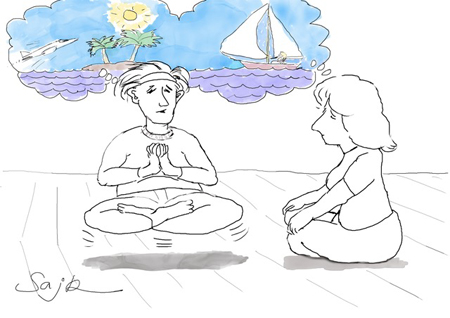
Cartoon by Simon Blackwood
The Nature of Thought
Elizabeth: Can you say more about this? How would you understand thought?
Judith: I read an article a few years ago in The New Yorker [/] written by researchers studying perception. They take the example of looking out into a backyard where there’s a white picket fence, and walking behind that picket fence there’s a yellow Labrador dog. We don’t actually perceive the dog; all we perceive are vertical slashes of white and yellow: the white fence, the yellow dog. But when asked what is happening, we say that we can see a dog walking behind a fence. So how does the brain come up with that? In neuroscience, this is called ‘the binding problem’ [/].
And the answer is that our mind acts very much like the Google search engine. With Google, we start typing and the software offers us a dropdown menu which guesses what we are looking for. That is what our mind does. It takes in a stimulus and then it guesses what we are seeing, based on past experience. Apparently only 15% of what we see is based on reality and most of it is based on this guessing. This is why babies see a snake and aren’t afraid; they don’t yet know what it is. But they are gathering information all the time so that they can build their own dropdown menus.
I find it astonishing that 85% of what I think I’m seeing I’m actually making up in my own mind. This means that all the time I am projecting onto the world, based on my past experience. So to me, the practice of yoga is to somehow sit on the fence of consciousness where I can notice the mind doing its thing. Just as my skin makes sweat, my mind makes thoughts, and I try not to believe them completely, which is a way of getting rid of judgement. When we can get rid of judgement – by which I don’t mean discrimination – there is a space, a pause, and in that space there is an emptiness which gives way to compassion. Then compassion can fill us up and we can act out of compassion for self and others.
Elizabeth: So what do you see as the difference between what you call judgement and discrimination?
Judith: Discrimination is discussed in the yoga sutras as something we need to refine. It is the discrimination between what is real and what is unreal, the important and unimportant, the valuable and the not valuable. This choice is informed by understanding the effects of our choices. Judgement is a moral decision about a person or action, and acting on that moral judgement of ‘who a person inherently is’.
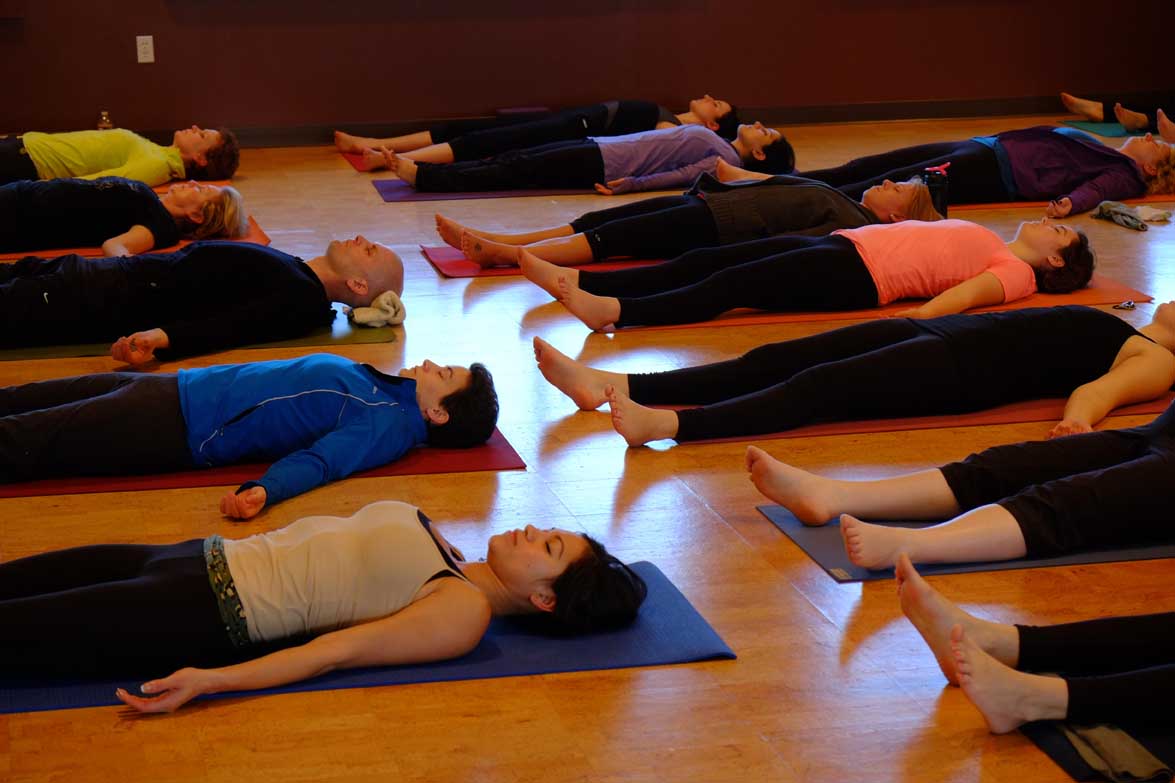
Yoga students in savāsana or corpse pose. Photograph: National Geographic Creative / Alamy Stock Photo
Elizabeth: Are there specific yoga practices that can help us cultivate this ‘space’ which allows compassion to flow into us?
Judith: To me this is what we begin learning when we do savāsana – the relaxation pose which we do at the end of every yoga class. We relax the different parts of our body and then the teacher often says something like: “watch the waves of the mind rising and falling”. In this way, we begin to separate awareness from thought. And this is the measure of freedom. Freedom is the most important thing any human being can ever learn: to know that we have thoughts but we are more than our thoughts. This is what is embodied in savāsana. I think of it as a dis-identification, because I feel that we have a false identification with our thoughts, especially in the west.
To have a little of that freedom is not to discount the power of the intellect. If I want to hang a picture here in my office, I will go downstairs and get a hammer and a picture hanger; then I’ll do the measurements, use the hammer and hang the picture. But I don’t carry the hammer with me all day long. I put it down. But we don’t do that with our thoughts: we carry them with us. We are like Gollum and his ring; we have our beliefs and our thoughts – “My precious! My precious!” – and we hold onto them. He is a very good example for us.
Elizabeth: In Yoga Sutra 1.3, Patanjali goes on to speak of this state of awareness which is before or beyond the mind, and of which the mind is merely the instrument. We tend to assume – as you’ve been pointing out – that we are our minds, and that consciousness belongs to the mind, but this is not what the yogis found to be the case. This seems to be an extraordinary discovery.
Judith: Yes. I think it is the discovery. Patanjali says of this: “And then the Seer abides in its own nature.” What he is telling us in these first few verses is that yoga is a state of being. It is only in the second chapter that he tells us that it is a practice, when he says: “Oh, by the way, if you haven’t reached the state of yoga, this is how you do it.” But in the western world we are really focussed on yoga as practice, and not yoga as a state of being.
I like to think that what we are all doing on the planet in our own way is moving towards what I call ‘integration’. When we first start practising yoga we are very interested in transcendence. We want to get out of the mind; we want to control the body; we want to become enlightened. So we start cutting things out; we eat in a certain way; we only want to do certain things, or to read and think about certain things. We behave as if we believe that the goodness we seek is outside of ourselves. It’s in the guru. Or we think: if I just take this meditation retreat; if I hang this tangka on my wall; if I stand on my head for five minutes; then… . We are trying to transcend ourselves. All of this is dualistic because one side of ourselves is trying to conquer another.
And actually, this is a necessary stage we all go through. It’s what I call ‘the ascent’, which is a theory based on the writings of Sri Aurobindo, who developed the practice called Integral Yoga [/]. It’s the ascent towards something beyond ourselves. We go into Christian churches and we look up at the cross; the cathedral is built to lift us up. For a lot of yoga teachers also, āsana is always about up: lift up; move up; stretch up; stretch out. To me, this is the transcendent stage. But then as our practice matures, we begin to be on the path of descent, a path of integration, and we become the yoga. Then there is nothing that is not the yoga: me talking to you now with awareness; how I treat the grumpy waiter. Divinity is everywhere. Everyone is Buddha, or no one is Buddha. What I say, do, how I walk, how I treat myself, you, how I treat everyone, my students – it’s all integrated. There is no way not to be swimming in the sea of Divinity.
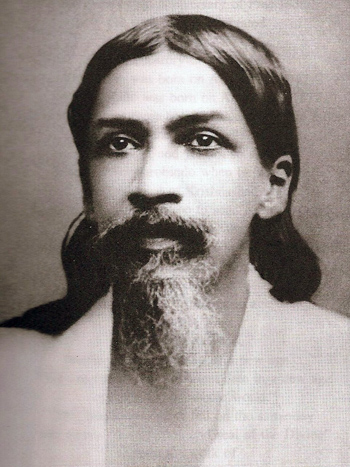
Sri Aurobindo
Elizabeth: Can you say more about this integrated state of consciousness? How does yoga practice – āsana, pranāyāma, meditation – lead to this goal of “the Seer abiding in its own nature”?
Judith: I make a distinction between consciousness and awareness. I think the transcendent state is about withdrawing from the world; and the integrated stage, the descent, is about being radically present with everyone – seeing everyone as divinity, even yourself. In my view, our practices in the west have overdone the notion of ‘consciousness’ as a state of ‘being aware of everything’. Understood like this, it can become a very mental, controlling practice. But enlightenment is not a mental experience: it comes from the gut, from the belly. It’s an embodied, visceral feeling, and I think we have all had moments of experiencing it. It’s a deep awareness that floods the body.
So in a way, what we are talking about is also a physical thing – a physiological shift. Scientists tell us that advanced students of the Dalai Lama can be shown to have physical brain changes as a result of their meditation. The part of the brain that has to do with compassion and empathy is much larger in them than in the average person because that is what they embody; it is what they have literally become. So we are not just talking about psychological or spiritual integration: it is psychological, emotional, physical, spiritual – it is everything. Who told us that the body wasn’t the spirit? It was Descartes who came up with the idea that the spirit was somehow separate from the body, but this cannot be the case.
Elizabeth: Do you think that it is because of this disassociation between mind and body that hatha yoga is so popular in the west? If we look back to the Indian tradition, as developed in the Bhagavad Gita, hatha yoga is not one of the original forms of yoga. They talk about karma yoga (of action), bhakti yoga (of devotion), jnana yoga (of knowledge) and raja yoga (with an emphasis on meditation). The development of a physical yoga focussing on the body is a later development.
Judith: I think that hatha yoga is an emergency first aid for the western mind, because we are so disconnected from our bodies. We don’t walk long distances. We sit. All the things we do disconnect us from our bodies – and we need to find God in the body. We can get so intellectual and feel that we need to understand everything. But I think that understanding is overrated. Someone can understand a lot about Buddhism, and still be miserable. We have to feel this sense of awareness in our gut, in the moment. So I think this is exactly where the pendulum needs to swing.
Nevertheless, at the same time, I decry and bemoan the fact that the way that physical yoga is taught has become so much like the rest of our culture. It’s fast; it’s hard; it’s hot; it’s challenging. This is one of the reasons I focus so much on what I call ‘restorative yoga’ – which is about just being, not doing. It’s not that I don’t like active āsana, but we people in the western world don’t need more of anything. We work very hard, and whilst we may sleep – although generally not enough – we rarely take time to really rest. Restorative yoga poses help us to do this. During deep relaxation, all the organ systems of the body are benefitted. There are measurable results, such as the reduction of blood pressure and the improvement of immune function, as well as with digestion, fertility, elimination, and the reduction of muscle tension and fatigue.
So I think that, as busy western people, what we need to do is first of all take a 20-minute savāsana every day – to just lie on the floor and feel our breathing. We need to invite more emptiness into our lives.
Yoga and Ethics
Elizabeth: Can I just go back to something you said earlier? You were talking about empathy and compassion, and it seems to me that the test of any spiritual practice is how it changes our attitudes to ourselves and to other people. As you pointed out, the yoga sutras begin with such principles.
Judith: A Buddhist teacher once told me that if you want to know how your practice is going, ask how is your life going. That doesn’t mean you get everything you want. What it does mean is that you are less reactive: you are a little happier, even though hard things happen. Your pendulum doesn’t swing so widely.
Ethics are of course extremely important. I think that the most important job I do as a yoga teacher is to reflect back the inherent goodness and inner wisdom of a student. And the only way I can do that is by finding my own inherent goodness and inner wisdom. The teacher is really just reminding the student that they are already good – by reflecting it back, by seeing it in them. If we do that, we cannot do any harm.
For instance, I am meticulous with the money I receive from teaching yoga, which is sometimes paid to me in cash. I don’t do this because I am a ‘good’ person, but because I believe that if I don’t do this right, I’m the person who is ultimately going to suffer. No one ever gets away with anything. There’s a price to be paid for lying. And it’s not just the effect on other people; in order to lie to others, I first have to lie to myself. There’s a book I recommend by the neuroscientist Sam Harris, called Lying [/]; actually, it’s really more like a long essay than a book. He says that lying is the single most detrimental thing you can do in a relationship because it erodes trust. And once you erode trust, you can never really get it back.
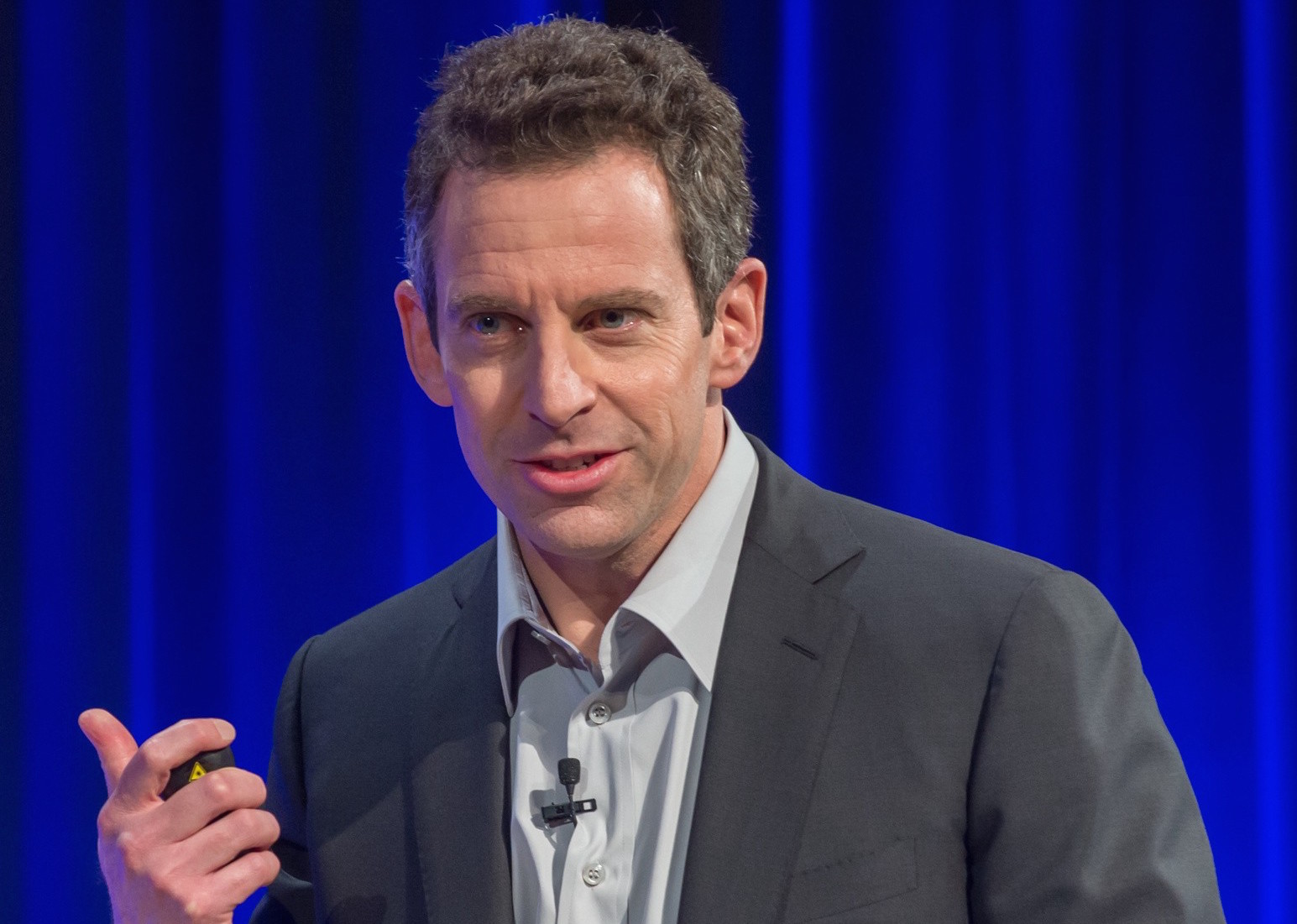
Sam Harris at ‘Waking Up’, San Francisco 2014. Photo: Callinus CC BY 2.0 [/], via Wikimedia Commons
What in part originally drew me to yoga was the yamas and niyamas, which say things like: ‘Tell the truth’, ‘don’t lie’, ‘don’t be greedy’, ‘don’t steal’. But yoga, unlike the Christianity in which I was brought up, doesn’t tell us that if we do these things, we are bad people. It says: don’t waste your time lying and stealing and cheating, because in the end it’s not going to get you the happiness that you think it’s going to give you. It’s very practical in that way. And that’s how I look at it. If I cross boundaries with my students, if I don’t report my income truthfully, if I act in an unethical way, the power of my teaching is affected on some subliminal level.
Elizabeth: It’s interesting to note the difference between the Abrahamic religions that say we suffer because of original sin, and the view of Eastern religions that say we suffer because we are ignorant, because we don’t understand, we don’t know who we are.
Judith: This is what is called avidya, which in the Yoga Sutras is often translated as ‘ignorance’, but it’s not really what we normally understand by ignorance. Avidya means actively being in the state of not seeing the true nature of reality: it is something we actively do and participate in.
As for sin: well – I was raised in the American South, going to church Wednesday night and twice on Sunday, and what I heard there was that we are all sinners. I used to think: “Really? I’m going to hell because I was mean to my brother. Hitler killed six million Jews and other people, but we are both going to hell?” I couldn’t understand it. So in the end I have come to the conclusion that there is only one sin, which is the false belief in separation: my separation from Divinity, from myself, from others. There is in reality no separation – but once I believe I’m separate from you, then I can harm you.
Here is a story I like. There was a guru who had a disciple who came to him every day to listen to his teachings. One day the guru said: “I am directly connected to God.” The disciple went home and he thought about that. He came back the next day and he said: “Guruji, isn’t it egotistical to say that you are directly connected to God?” The guru looked at him, and said: “It’s egotistical to think you’re not!”
Elizabeth: Yes, I sometimes think that there are two ways that we can go wrong. One is to think we are God, and the other is to think we are not!
Judith: Exactly. And in an integrated understanding, both points of view have a place. There is no place which is not on the path. There is nothing else to do but evolve. We are all doing it in our own way through our own proclivities, finding that which draws us.
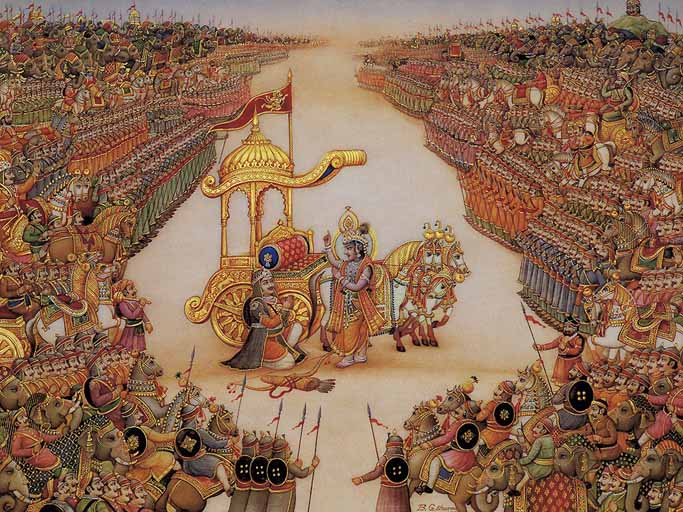
The Bhagavad Gita, showing Krishna instructing Arjuna as the two armies prepare to fight. Image: http://isha.sadhguru.org
Elizabeth: May I ask you one final question, about the matter of ‘detachment’? In the yoga sutras, Patanjali says that the goal of yoga is achieved through abhyasa and vairagya, which can be translated as ‘practice and detachment’. Similarly, in the Bhagavad Gita, Krishna speaks to Arjuna at length about different forms of non-attachment or dispassion. He gives the image of someone constantly serene, above the mundane aspects of life – someone who ‘ treats a clod of earth and gold just the same’.
Judith: I think non-attachment is a difficult concept for us, and a very misunderstood one, because the word in English connotes some kind of not caring – a state of being neutral, grey, boring, disinterested. But for me, disinterest is not a synonym for non-attachment. One of the things I tell my students is: “Don’t confuse preference and attachment”. This is how I explain it, because I like to explain things through stories. You probably have a favourite restaurant – everyone does. If you’re like me, you tell yourself as you are on the way to it, that you are going to try something new this evening, but in the end you always order the same thing. You do this because that’s why you go there: you like a certain thing that they make better than anybody, and you want that. That is preference, not attachment – and it is not the cause of suffering.
The suffering comes when you get there and they say: “We don’t have that today”. So, what then arises in your body-mind? Some people get angry, some people get sad – and that’s the attachment. So non-attachment doesn’t mean you don’t have a preference for a blue mat over a green mat. But when you go to the yoga studio and they don’t have any blue mats, can you take that in your stride, or are you upset about it?
So attachment is a process, not a thing. It’s a verb, not a noun. It’s what you do when you don’t get your preference – because we all have preferences. So attachment for me is what I notice in myself when things don’t go the way I like. And also – this is a more subtle one – what arises in me when I don’t act the way I want to act, or when I feel irritated or slightly depressed or angry, and I hear a voice within me saying: “What’s wrong with me? Why am I feeling this way?” Then I notice that I’m attached to not feeling this, rather than being able to accept what’s arising in me, which could be anger. Human beings get angry – so sometimes I just find myself feeling angry, and accepting that is the process of non-attachment. It doesn’t mean that I never get angry.
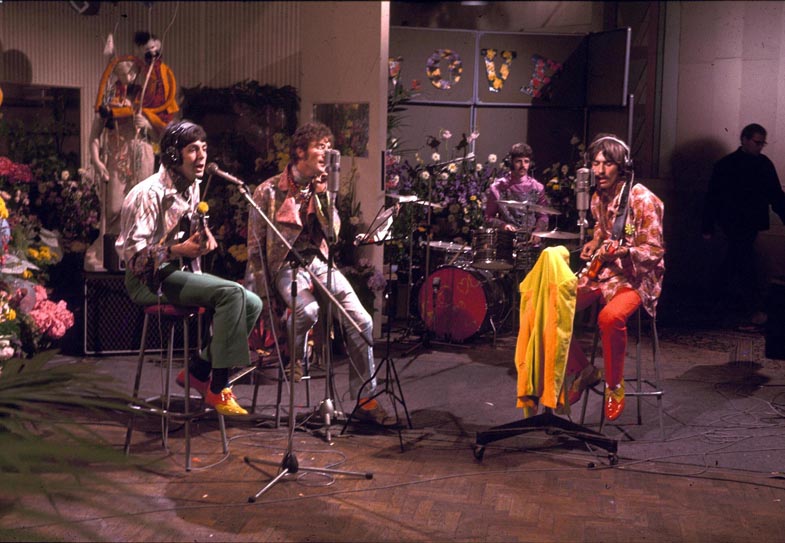
The first performance of “All You Need is Love” by The Beatles, who wrote it for the Our World broadcast, the first live satellite link-up connecting 14 countries, on 25th June, 1967. Photograph: David Magnus/RexShutterstock
Elizabeth: In your book Living Your Yoga, you say as one of your daily mantras that “detachment is the greatest act of love”. How do you understand this?
Judith: The Beatles have the answer to that. You remember that song they wrote, entitled ‘All You Need is Love’. What happens is that these practices of non-attachment – and in fact, every other kind of practice of awareness and consciousness – act as a kind of speed bump. They are a mental, emotional or physical pause which slow us down, so that we remember the most important thing. And that is love. It’s the ground of our being. And kindness.
Remembering is so important. It is not difficult to be aware; the problem is remembering to be aware. So before I go teach a class, I always try to listen to a little bit of music. I love music, and I’ll listen to something that opens up my heart. Just the sheer beauty of it moves me, so I go into the classroom with an open heart, remembering my highest value – that everyone is Buddha – and also remembering just to be kind. I always ask my teacher-trainees to write down three or four things that they can reliably do – not yoga or meditation – that get them into that space of opening up their heart. Pet your dog. Go into the woods. Look at flowers – really look at them. Do something that opens your heart, and remember that space.
One of the best ways to get into that space where we remember the ground of our being is gratitude. You cannot be grateful and greedy at the same time. You cannot be grateful and disconcerted at the same time. You cannot be grateful and angry at the same time. So whenever you can, invoke gratitude.
Email this page to a friend
FOLLOW AND LIKE US
——————————————
——————————————
——————————————
FOLLOW AND LIKE US
If you enjoyed reading this article
Please leave a comment below.
Please also consider making a donation to support the work of Beshara Magazine. The magazine relies entirely on voluntary support. Donations received through this website go towards editorial expenses, eg. image rights, travel expenses, and website maintenance and development costs.
READ MORE IN BESHARA MAGAZINE
Ayurveda: A Medical Science based on Consciousness
Dr. Sunil Joshi talks to Elizabeth Roberts
Thought for Food
Charlotte Maberly on the new science of Gastronomy
A Biology of Wonder
Dr Andreas Weber talks about a new way of understanding nature
A “Quite Interesting” Approach to Education
John Lloyd talks about the philosophy behind the QI project
READERS’ COMMENTS

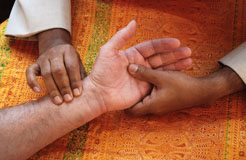
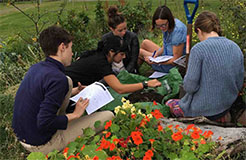


Thanks for publishing this piece. A small but significant note: The questioner suggests suffering is understood through the doctrine of original sin within Abrahamic religions as opposed to eastern traditions. To be clear, Islam forthrightly rejects original sin in its entirety.
Thank you Joseph for making this point about Islam’s rejection of original sin, which is fully accepted.
What I am curious to ask now is your understanding of the beautiful story of Mohammad as a young boy in the desert, when he was visited by angels who opened his chest, removed his heart, and purified it of the clot of blood before replacing it. This suggests that even the best of human beings has in his nature the potential for error or ‘sin’ and it is through divine grace alone that this is removed.’ Elizabeth
17 Mukhi Rudraksha gives power of effective decision making.